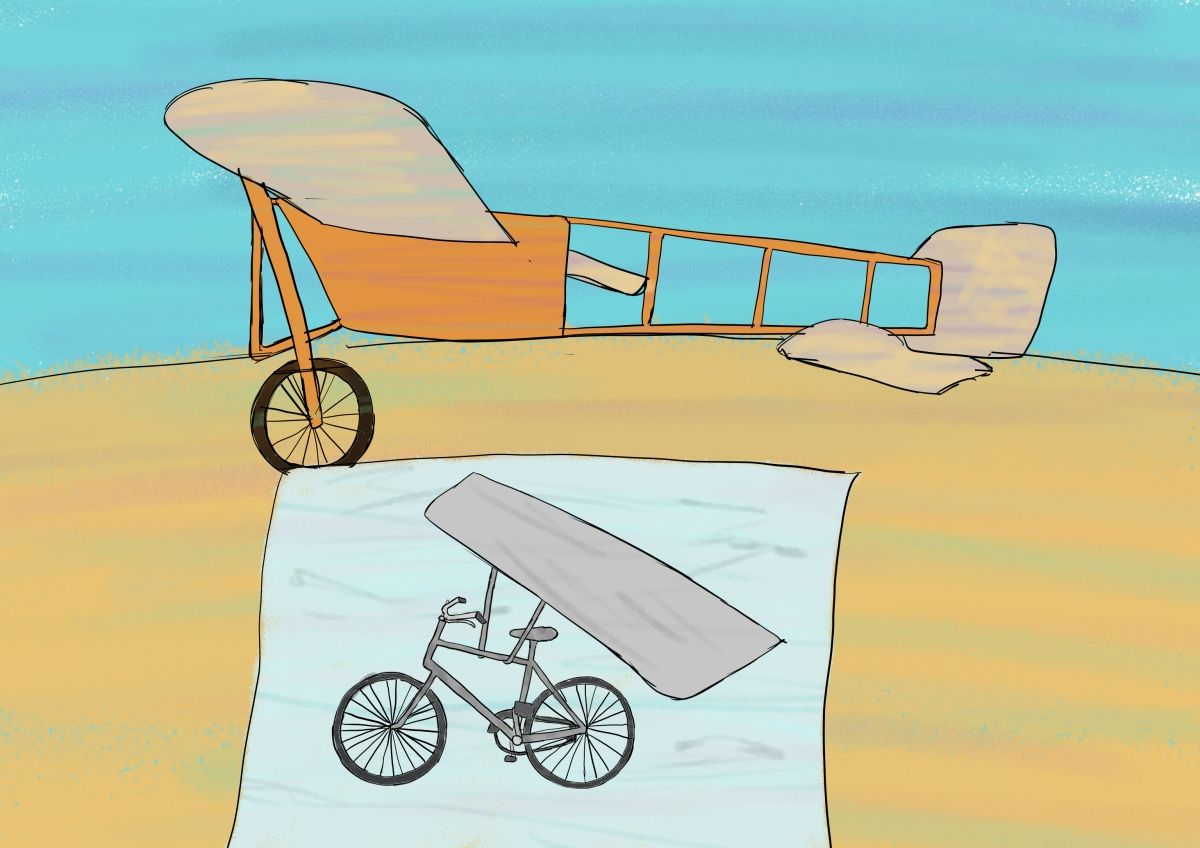Snipette - Taking Flight
|
Older messages
Purely out of Language
Friday, May 19, 2023
Language can influence the way you think. But do robots think? Snipette Snipette Purely out of Language By Badri Sunderarajan – 19 May 2023 – View online → Language can influence the way you think. But
Graffiti
Friday, May 12, 2023
The words of the prophet are written on the subway walls. Snipette Snipette Graffiti By Reva T. – 12 May 2023 – View online → The words of the prophet are written on the subway walls. One of my
Mouse with a Human Ear
Friday, May 5, 2023
Fixing machines is easy; fixing living creatures is hard. Or is it the other way round? Snipette Snipette Mouse with a Human Ear By Thakshila Wijesinghe – 05 May 2023 – View online → Illustration
WhaleGPT
Friday, April 28, 2023
AI can work wonders with human language. Can it also help us talk to whales? Snipette Snipette WhaleGPT By Anirudh Kulkarni – 28 Apr 2023 – View online → AI can work wonders with human language. Can it
Extraterrestrial Heaven
Friday, April 21, 2023
Can we rebuild to have innovation without bureaucracy? Snipette Snipette Extraterrestrial Heaven By Avi Loeb – 21 Apr 2023 – View online → Can we rebuild to have innovation without bureaucracy?
You Might Also Like
• Book Series Promos for Authors • All in one order • Social Media • Blogs
Wednesday, January 15, 2025
~ Book Series Ads for Authors ~ All in One Order! SEE WHAT AUTHORS ARE SAYING ABOUT CONTENTMO ! BOOK SERIES PROMOTIONS by ContentMo We want to help you get your book series out on front of readers. Our
🤝 2 Truths Every Biz Buyer Should Know
Tuesday, January 14, 2025
Plus 1 Game-Changing Idea for SMB Acquisition Biz Buyers, Welcome to Main Street Minute — where we share some of the best ideas from inside our acquisitions community. Whether you're curious or
Artistic activism, the genetics of personality & archeological strategies
Tuesday, January 14, 2025
Your new Strategy Toolkit newsletter (January 14, 2024) ͏ ͏ ͏ ͏ ͏ ͏ ͏ ͏ ͏ ͏ ͏ ͏ ͏ ͏ ͏ ͏ ͏ ͏ ͏ ͏ ͏ ͏ ͏ ͏ ͏ ͏ ͏ ͏ ͏ ͏ ͏ ͏ ͏ ͏ ͏ ͏ ͏ ͏ ͏ ͏ ͏ ͏ ͏ ͏ ͏ ͏ ͏ ͏ ͏ ͏ ͏ ͏ ͏ ͏ ͏ ͏ ͏ ͏ ͏ ͏ ͏ ͏ ͏ ͏ ͏ ͏ ͏ ͏ ͏ ͏ ͏ ͏ ͏
Reminder: B2B Demand Generation in 2025
Tuesday, January 14, 2025
Webinar With Stefan and Tycho ͏ ͏ ͏ ͏ ͏ ͏ ͏ ͏ ͏ ͏ ͏ ͏ ͏ ͏ ͏ ͏ ͏ ͏ ͏ ͏ ͏ ͏ ͏ ͏ ͏ ͏ ͏ ͏ ͏ ͏ ͏ ͏ ͏ ͏ ͏ ͏ ͏ ͏ ͏ ͏ ͏ ͏ ͏ ͏ ͏ ͏ ͏ ͏ ͏ ͏ ͏ ͏ ͏ ͏ ͏ ͏ ͏ ͏ ͏ ͏ ͏ ͏ ͏ ͏ ͏ ͏ ͏ ͏ ͏ ͏ ͏ ͏ ͏ ͏ ͏ ͏ ͏ ͏ ͏ ͏ ͏ ͏ ͏ ͏ ͏ ͏
Why Some Types of Art Speak to You More Than Others
Tuesday, January 14, 2025
Your weekly 5-minute read with timeless ideas on art and creativity intersecting with business and life͏ ͏ ͏ ͏ ͏ ͏ ͏ ͏ ͏ ͏ ͏ ͏ ͏ ͏ ͏ ͏ ͏ ͏ ͏ ͏ ͏ ͏ ͏ ͏ ͏ ͏ ͏ ͏ ͏ ͏ ͏ ͏ ͏
How Chewbacca Roared a Woman into New Teeth
Tuesday, January 14, 2025
It started as a prank. A funny, and mostly harmless one -- annoying, sure, but most pranks are.
🧙♂️ [SNEAK PEEK] Stop giving brands what they ask for…
Tuesday, January 14, 2025
Why saying “no” could actually be your smartest move ͏ ͏ ͏ ͏ ͏ ͏ ͏ ͏ ͏ ͏ ͏ ͏ ͏ ͏ ͏ ͏ ͏ ͏ ͏ ͏ ͏ ͏ ͏ ͏ ͏ ͏ ͏ ͏ ͏ ͏ ͏ ͏ ͏ ͏ ͏ ͏ ͏ ͏ ͏ ͏ ͏ ͏ ͏ ͏ ͏ ͏ ͏ ͏ ͏ ͏ ͏ ͏ ͏ ͏ ͏ ͏ ͏ ͏ ͏ ͏ ͏ ͏ ͏ ͏ ͏ ͏ ͏ ͏ ͏ ͏ ͏ ͏ ͏ ͏
Book Promos • SIX posts each day on X.com • Over 33 days •
Tuesday, January 14, 2025
Tweeted 6 times daily for 33 days only $33 Logo ContentMo Tweets Your Book to Our Twitter Followers Each Day We TWEET Your Book for 33 Days, 6 Times/Day = 198 tweets SEE WHAT AUTHORS ARE SAYING ABOUT
The Ad. Product Backlog Management Course — Tools (4): GO Product Roadmap and the Now-Next-Later Roadmap
Monday, January 13, 2025
The 25000 Feet Level of the Course's Alignment Model ͏ ͏ ͏ ͏ ͏ ͏ ͏ ͏ ͏ ͏ ͏ ͏ ͏ ͏ ͏ ͏ ͏ ͏ ͏ ͏ ͏ ͏ ͏ ͏ ͏ ͏ ͏ ͏ ͏ ͏ ͏ ͏ ͏ ͏ ͏ ͏ ͏ ͏ ͏ ͏ ͏ ͏ ͏ ͏ ͏ ͏ ͏ ͏ ͏ ͏ ͏ ͏ ͏ ͏ ͏ ͏ ͏ ͏ ͏ ͏ ͏ ͏ ͏ ͏ ͏ ͏ ͏ ͏ ͏ ͏ ͏ ͏
Using this free CRO tool?
Monday, January 13, 2025
Improved insights, results and workflow. ͏ ͏ ͏ ͏ ͏ ͏ ͏ ͏ ͏ ͏ ͏ ͏ ͏ ͏ ͏ ͏ ͏ ͏ ͏ ͏ ͏ ͏ ͏ ͏ ͏ ͏ ͏ ͏ ͏ ͏ ͏ ͏ ͏ ͏ ͏ ͏ ͏ ͏ ͏ ͏ ͏ ͏ ͏ ͏ ͏ ͏ ͏ ͏ ͏ ͏ ͏ ͏ ͏ ͏ ͏ ͏ ͏ ͏ ͏ ͏ ͏ ͏ ͏ ͏ ͏ ͏ ͏ ͏ ͏ ͏ ͏ ͏ ͏ ͏ ͏ ͏ ͏ ͏ ͏ ͏
